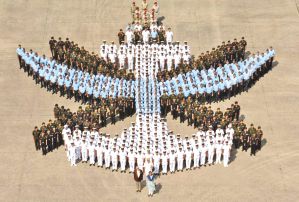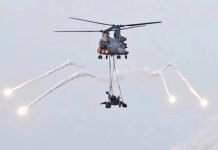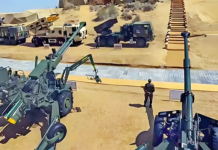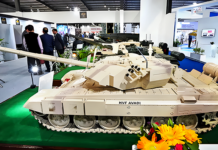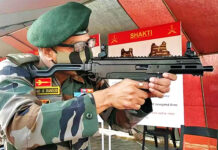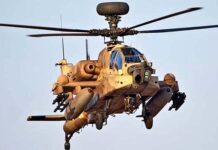The Department of Military Affairs (DMA) has set a target of rolling out the first “theatre command” by 2022, and before that, it is setting up two integrated commands – Air Defence and Peninsular. A thorough study will be carried out on having them and the number of regional commands required. The Services are still examining if J&K will be a separate theatre command, which would include the international border with Pakistan. The DMA is also looking to have a common training command and a common war doctrine, as well.
A theatre command will provide all assets for war under a single commander. One of the key objectives behind jointness, or jointmanship, is the setting up of theatre commands for the best use of military resources to fight future wars. Theaterisation refers to placing specific units of the army, the navy and the air force under a theatre commander. Such commands come under the operational control of an officer from any of the three Services, depending on the function assigned to that command.
“There can be a number of theatre commands, including the Peninsular Command (for the southern part of the state), an Air Defence Command, a Joint Logistics Command, a Space Command, a Training Command and other theatre commands in the eastern, northern and western commands, which take care of China and Pakistan. The commands could be divided into more than one theatre commands,” Gen Bipin Rawat, Chief of Defence Staff (CDS) and head of the newly created DMA, said on 4 February.
The aim is to cut costs and right-size manpower, in the backdrop of the ballooning pay and pension bills of the almost 15-lakh strong armed forces, as well as build an integrated land-air-sea machinery for wars of the future. With the annual defence outlay unlikely to register a major jump, Gen Rawat said there must be better utilization of resources.
During the transitional phase the current command & control structures will continue with the theatre commanders reporting to their respective service chiefs.
CDS’s Brief
In a landmark decision, the government, on 24 December 2019, had approved the creation of a CDS in the rank of a four-star general who acts as the principal military adviser to the defence minister on all matters relating to the tri-services.
The government also decided to create a new Department of Military Affairs (DMA) under the defence ministry, which is headed by the CDS as its secretary.
The CDS has been given three years for the creation of theatre commands. It will require a firm push due to bitter turf-wars among the three Services, institutional resistance and strong objections in the past from the IAF.
The CDS said a complete analysis of the threats is underway and there would be inter-theatre or intra-theatre re-allocation of resources on that basis, which would also result in cutting costs.
The process to set up joint theatre commands will kick off from next year onwards, after first integrating air defence, drone operations, logistics, medical services and the like among the Army, Navy and Indian Air Force (IAF).
The CDS has a key role in ensuring optimum utilisation of allocated budget, ushering in more synergy in procurement, training and operations of the services through joint planning and integration.
Another major mandate of the CDS is to facilitate indigenisation of weapons and equipment to the maximum extent possible while formulating the overall defence acquisition plan for the three Services.
Geographical Theatre Commands
The setting-up of “geographical” theatre commands, where all assets and manpower of the Army, Navy and IAF will be placed under one operational commander in a region, along with “functional” tri-Service commands for air defence, logistics and training, will be the biggest-ever military restructuring in India’s history. At present, the Army, Navy and the Air Force have separate commands.
The proposed plan is to establish one or two commands (a northern one west of Nepal and an eastern one east of Nepal) to handle China, one or two commands on the western front with Pakistan (one in J&K and the other to include Punjab, Gujarat and Rajasthan) and a southern command for peninsular India.
Air Defence Command
In his first official directive after stepping into the new role of CDS, Gen Rawat directed top officers of HQ Integrated Defence Staff (IDS), in January, to prepare a proposal to create an Air Defence Command to enhance military synergy.
“In order to become the armed forces of the Union, we need to start working on some of the aspects where we think immediate integration can happen. There, we find that air defence is one area, which according to me, is a low hanging fruit and can happen in a time-bound manner,” the CDS said.
A team headed by Vice Chief of the Indian Air Force is conducting a study to set up the air defence command and it has been told to complete the study by March 31. The report was expected by March 31. It would integrate all air-defence assets under the IAF, including the coastal guns of the Navy and ground-based air-defence missile launchers of the Army.
The responsibility of the management of the airspace is that of the Air Force, therefore, the security and safety of the airspace must rest with that one Service. To be headed by an IAF officer, the it will include air defence resources of all the three Services. While the air defence is primarily the responsibility of the IAF, every Service has its own air defence systems, which Rawat said, should integrate under one Service so that the command and control issues are simplified.
“While air assets will be integrated,” and put in the Air Defence Command, those with very specific duties such as fighters with the Indian Navy or air elements with the Strike Corps of the Indian Army will continue to be with the respective forces, he explained. Integrating the logistics units of all three services “has great potential” in increasing “efficiency”, and cutting costs through “common contract management”, the CDS said.
Peninsular Command
India is looking at integrating the western and eastern naval commands to create a Peninsular Command, which will look to merge the eastern and western naval commands. The Navy has been sounded out and a formal study is being ordered. The idea being that the security of the Indian Ocean Region (IOR) has to be the responsibility of a single commander. He will be given air assets and Army troops (for carrying out amphibious operations), according to Gen Rawat.
The existing tri-Services command at Andaman and Nicobar Islands would remain as it is, he said. There is a plan to upgrade the three runways available on the island chain.
“The Navy Chief looks at the entire Indian Ocean region from east coast of Africa to Australia,” Rawat explained. Therefore, with the creation of the Peninsular Command, the Navy Chief can disinvest himself from the closer Indian Ocean region and look at the bigger picture. While the peninsular theatre commander will deal with the maritime boundaries, the Navy HQ at New Delhi would look at the “big picture” of the Indian Ocean Region to safeguard India’s interests stretching from East Africa to Australia and Malacca Strait.
Rawat said a study to create the Peninsular Command, responsible for securing India from seaborne threats, will be ordered by March 31, with a report to be submitted three to four months thereafter. He said the Peninsular Command was likely to be functional by 2021-end with army and air force elements under it. The Port Blair-based Andaman & Nicobar Command, India’s first tri-Services command, would remain as it is.
The peninsular command will integrate the existing Western Naval Command (HQs at Mumbai), Eastern Naval Command (Vizag), Southern Naval Command (Kochi) and Southern Army Command (Pune).
IAF’s Reservations
The IAF believes it would be operationally irrational to divide the country’s “limited air assets” among different theatre commands. IAF stands to lose the most with the proposed restructuring. Both the 1.4-lakh IAF and the over 12-lakh Army have seven commands each, headed by three-star Air Marshals or Lt-Generals, with the 59,000-strong Navy restricting itself to just three commands.
When the joint commands do come up, IAF is likely to be left only with the Air Defence Command, along with commands to handle space and training in the future. Though IAF headquarters will retain some air assets, each theatre command will also be given some integral fighter jets and helicopters.
Procurement System
The prioritisation of military purchases to be made by the three Services also comes under CDS’s purview. He indicated that he prefers a procurement model that involves buying weapons and systems in a staggered way so that the requirement of the three Services can be met within the available budget.
“I believe we should not go in for a large number of procurements at one time. If you have a requirement for, say, 10 submarines, 100 fighter jets and 1,000 tanks, you can either buy the submarines or the jets or the tanks. You can’t buy all three together. But you can spread out the purchases over 10 years and buy that equipment in four or five tranches,” said Gen Rawat.
He said buying equipment in one go would also result in all of it becoming due for repairs and overhaul at the same time. He added that he would prefer the IAF’s requirement for 110 new fighter jets to be met in phases.
Gen Rawat said the newly created Department of Military Affairs will handle revenue procurement while the capital procurement will continue to be looked after by the defence secretary.
Logistics Command
The armed forces are likely to create a Logistics Command. The CDS said “There is a great scope of logistics issues being integrated. Giving the example of medical resources, Rawat said among all three Services, surpluses and deficiencies need to be better managed so that the doctors are neither overworked nor under-utilised.
The Joint Logistics Command would look at common contract management for the three services and be responsible for common inventories for maintaining reserves. He said a countrywide analysis of surpluses and deficiencies of resources is underway and there is a scope of jointmanship for better optimisation and utilisation of facilities.
Gen Rawat said the medical arm of all the services should begin operating jointly and not in silos, and hospitals of individual services should operate as tri-service hospitals such as the R&R Hospital in Delhi.
In military stations, where services are co-located, there is scope for management of resources, he said. “For example, in Delhi, we are looking at a common transport management,” he said.
Comments
The 17-single service commands, which lack the requisite coordination among them, has led to needless wasteful expenditure and silo-mentality. The only two tri-Service commands are the geographical Andaman and Nicobar Command and the functional Strategic Forces Command to handle the country’s nuclear arsenal.
The US Department of Defense has 11 combatant commands, while China’s People’s Liberation Army (PLA) has five theatre commands.
The IAF has in the past opposed the setting up of theatre commands as many in the service believed the air force had the speed and reach to project military power across geographies without being confined to theatres. However, all the three service chiefs have extended their full support to the CDS in creating new military structures.
The CDS is focusing on creating avenues that allow the officers of the army, navy and air force to interact more with each other at different stages of their careers to have a better understanding of the three services. Theatre commands are required since no single force is capable of discerning and countering growing threats alone. India’s strategic frontiers are expanding, it is time to look at the bigger picture and not be confined to silos. The threats from other countries need to understood and prepared for.


